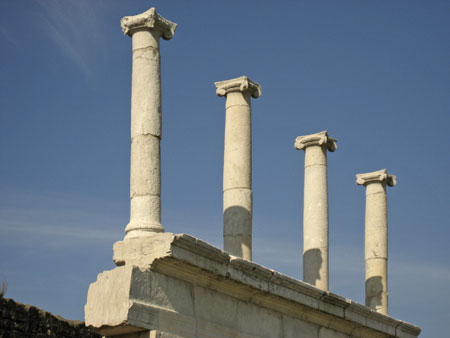
When Vesuvius erupted on August 24, 79 (CE), Pompeii, a vibrant city of around 20,000, as well as nearby Herculaneum and Stabiae, were buried in volcanic ash. We have an eyewitness account of what must have been an experience terrifying beyond measure. Pliny the Elder, who was commanding the Roman fleet stationed in the Bay of Naples, saw it happen. Alerted by his sister to — as his nephew writes several years later to Tacitus — “a cloud of unusual size and appearance,” Pliny decided to set sail with the fleet for a closer look and to rescue as many people as possible. In fact he, himself, perished on the shore. “When daylight returned on the 26th, two days after the last day he had been seen,” writes Pliny the Younger, “his body was found intact and uninjured, still fully clothed and looking more like sleep than death.” The cities remained buried until excavations began in 1748.
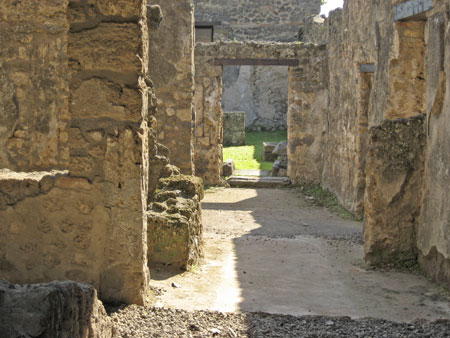
I’d seen pictures and documentaries, looked at Web sites, and read the guidebook. I’ve stood on Hadrian’s Wall. I’ve seen the stunning Pont du Gard. I’ve seen Roman remains and amphitheatres in England, France, Yugoslavia, and Italy. But nothing could have prepared me for the reality of Pompeii. You’re not seeing just one building or structure (however impressive); you’re walking along the streets of what was once an entire Roman city. You’re going into houses people lived in and shops where they bought food—complete with intact mosaic counters and deep tubs that would have held olives. You’re seeing the sidewalks they walked on and the public water fountains, fed by an aqueduct system that is surely one of the wonders of engineering, that they used on a daily basis. You’re touching stones they touched and looking at frescoes they commissioned as decoration for their villas.
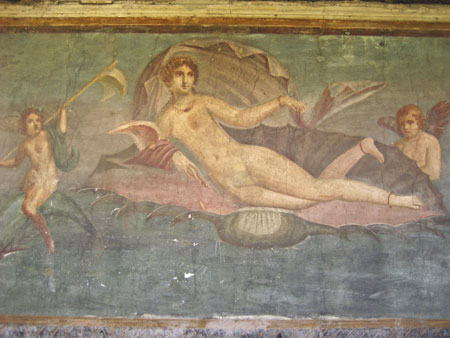
And everywhere you look, you know that you are seeing what was, for so many terrified people, the last thing they would ever see. I found it breathtaking and very moving.
Walking in a buried city
November 9, 2006City gate: II
August 5, 2006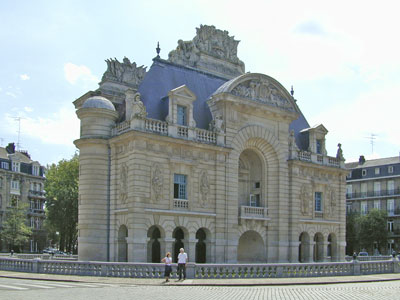
This is the Porte de Paris, which stands on the Place Simon Volant, named for the architect of the city gate and unveiled in 1692. It was originally called “la Porte des malades” because it led to the hospital.
The original moat is replaced by an ornamental garden.
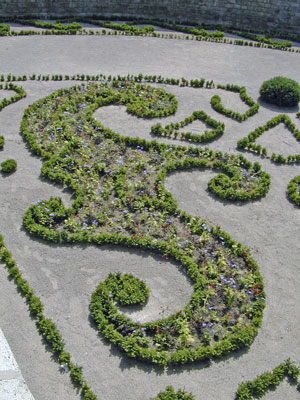
City gate: I
August 4, 2006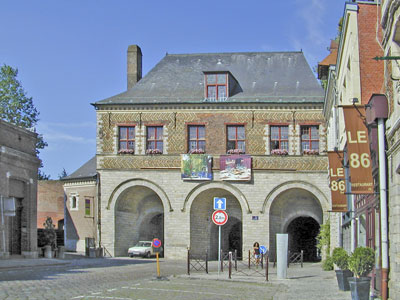
La Porte de Gand dates from the 1600s and is one of three remaining city gates to the old walled city of Lille. You approach the along cobblestoned streets that lead through a fashionable dining section of Lille. The gate itself houses a restaurant, la Terrasse des Ramparts.
Lydéric and Phinaert
July 30, 2006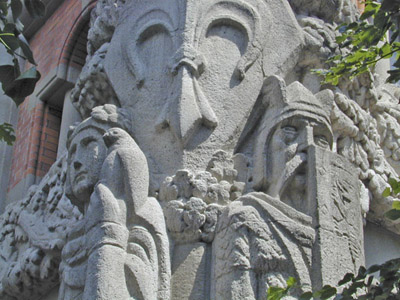
Here are the patron giants of Lille, Lydéric and Phinaert, supporting the tower of the Hôtel de Ville. According to legend—and I hope Elisabeth and MLL will put me right if I haven’t got the facts straight—in the year 620, a prince named Salvaert, fleeing an insurrection with his pregnant wife Ermengaert, was ambushed by Phinaert, a bandit lord. Salvaert was killed, but Ermengaert escaped and was taken in by a hermit. She gave birth to a son, Lydéric. When Lydéric was 20, he sought out Phinaert, challenged him to a duel, and defeated him. The King of France gave Phinaert’s lands to Lydéric, who founded the city of Lille.
There is apparently a wonderful view of the city from the tower, but it wasn’t open the day we were there. We had to content ourselves with looking around inside, where we found two more huge effigies of Lydéric and Phinaert in the auditorium.
French Flatiron
July 29, 2006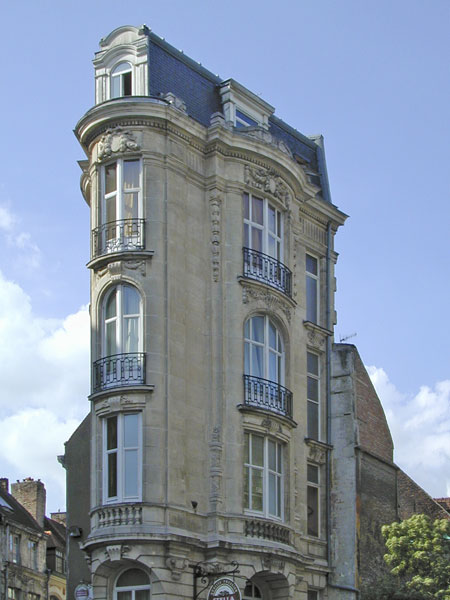
This building in Lille reminded me of the Flatiron Building in New York City, famously photographed in 1903 by Alfred Stieglitz.
I wonder if Elisabeth or MLL knows anything about this building. I would love to see one of the apartments (I assume it’s an apartment building). I imagine them as very elegant.
The art of the swimming pool
July 27, 2006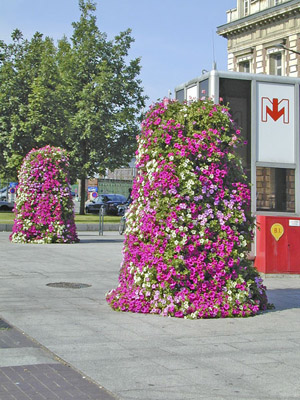
I have never seen anything like these wonderful petunia pillars before. They are in Roubaix, which is 20-minutes or so away from the center of Lille on the excellent automated métro. Roubaix was an important textile manufacturing town in the 15th to 19th centuries
But the main reason to go there today is to visit La Piscine.

Originally an Art Deco swimming pool, it is now the Musée d’Art et d’Industrie. The old pool is a gallery of 19th and 20th century sculpture. The tiled edge of the pool is still visible behind the statues. The stretch of water in the middle is about three inches deep.
The old shower stalls and changing rooms have been turned into display cases for—among other things—the splendid displays of textiles and related items, and the wings that made up the municipal bath house and once contained bath tubs now house the fine arts collection.
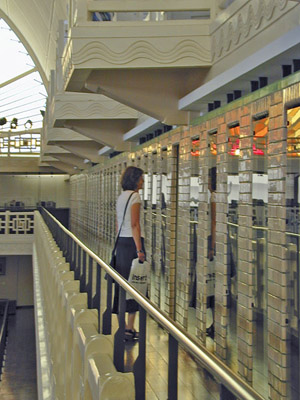
To remind you of this wonderful building’s past, every so often, you hear a couple of minutes of taped shrieking and splashing.
The architecture of commerce
July 25, 2006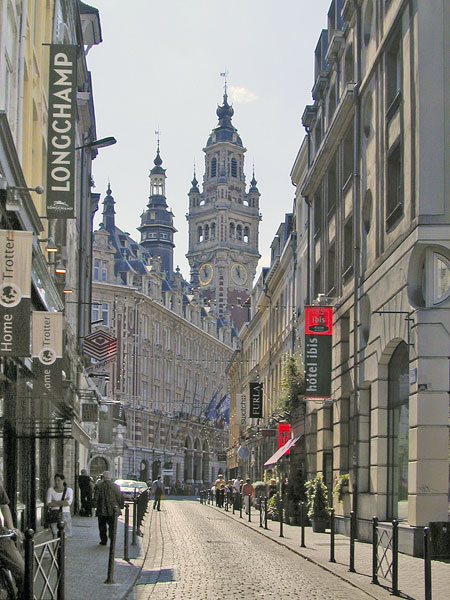
The exquisite 76m neo-Flemish belfry of the Lille Chambre de Commerce is seen towering above the buildings on this street. The Chambre was designed by Louis Marie Cordonnier and blends well with the style of such nearby buildings as the Vieille Bourse.
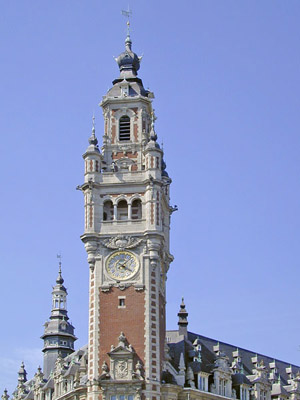
Below is the boxy Credit Lyonnaise tower, conceived by the architect Christian de Portzamparc as a block in the sky signalling renewal. It stands near the Gare Lille-Europe and the Euralille Centre.
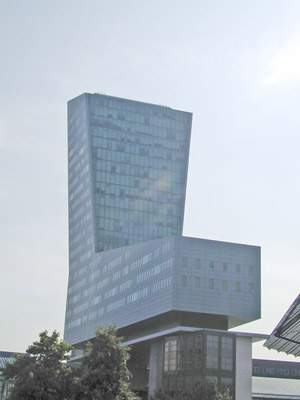
Two such different buildings, both representing commerce, both built in the 20th century, and both—to me—with their own distinctive appeal.
La Vieille Bourse: II
July 22, 2006We stepped into the courtyard and there in the cloisters was a book market. It’s there every weekday. What a pleasure to get out of the hot sun and join others browsing among the stalls of antiquarian and used books and watching the chess games.
I wasn’t in Lille on a Sunday, but apparently that’s when there are impromptu tea dances in the courtyard. It would have been too hot for much dancing when I was there.
Thanks to Marie of Alexandria Daily Photo for her four cliffhanger posts this week, which inspired me to make this a two-part post.
La Vieille Bourse: I
July 21, 2006This is one of the four doorways into the old Bourse de Commerce, a restored Flemish Renaissance building consisting of 24 17th century houses around a cloistered courtyard. Lions of Flanders adorn the doorways.
Step through one of the doorways into the courtyard, and you will find floral and fruit motifs and symbols of the original guilds that traded here in the 17th century decorating the cloisters. You’ll also find … well, I’ll tell you that tomorrow.
La maison Coilliot
July 20, 2006All the houses on rue Fleurus look pretty much the same. And then you come to number 14, the Maison Coilliot.
The original owner, M. Coilliot, wanted something different, so he commissioned Hector Guimard, the architect responsible for many of the Paris Métro entrances, to redesign his house. Guimard combined volcanic rock, cast iron, and Coilliot’s own ceramics to create this wonderful Art Nouveau facade with its swirling decorative motifs. It’s still a private residence, so you can’t see the interior. Even so, it’s well worth a visit if you’re in Lille.
Old and new
July 16, 2006Blackfriars Bridge is a railway bridge over the River Thames in London. The first structure was opened in 1864, but as time passed, it was not strong enough to support modern trains, so a replacement was built. However, the support columns of the old bridge remain, which makes for the kind of surrealistic view that I might have dreamed.
Royal Holloway College
July 15, 2006The University of London is a collegiate university, and this is Royal Holloway, one of the colleges (no relation to Holloway, the famous women’s prison). The college was founded in 1979 by Thomas Holloway, who made his fortune—several million pounds sterling of it—in patent medicines. He was looking for a philanthropic enterprise, and the college, which was originally for women only, was the suggestion of his wife Jane. Royal Hollway merged with the University of London’s Bedford College (also originally a women’s institution) in 1985, 20 years after both colleges began to admit men.
The architecture was inspired by the sixteenth century Chateau of Chambord in the Loire Valley, and the effect of Renaissance blended with Victoriana is completely over-the-top, but to my surprise, I found myself liking it for its sheer abandon and audacity.
The Gherkin
July 14, 2006This building, in London’s financial district and towering over the nearby Tower of London (which you can’t see in this picture), is known as “The Gherkin”—gherkin is a pickled cucumber—and less widely as the Crystal Phallus, a play on the famous Crystal Palace, site of the Great Exhibition of 1851. To me it looks more like a rocket waiting to launch.
The Gherkin, home to the Swiss Re reinsurance company, is the second tallest building in the City of London (an area of a square mile) and the sixth tallest building in the whole of London. The architects were Sir Norman Foster and former business partner Ken Shuttleworth.
According to Wikipedia, in December 2005, The Gherkin was voted the most admired new building in the world based on a survey of the world’s largest firms of architects, as published in 2006 BD World Architecture 200. On the other hand, in June 2006, it was nominated as one of the five ugliest buildings in London.
Tastes differ. I like it.



 Posted by Judith
Posted by Judith 









